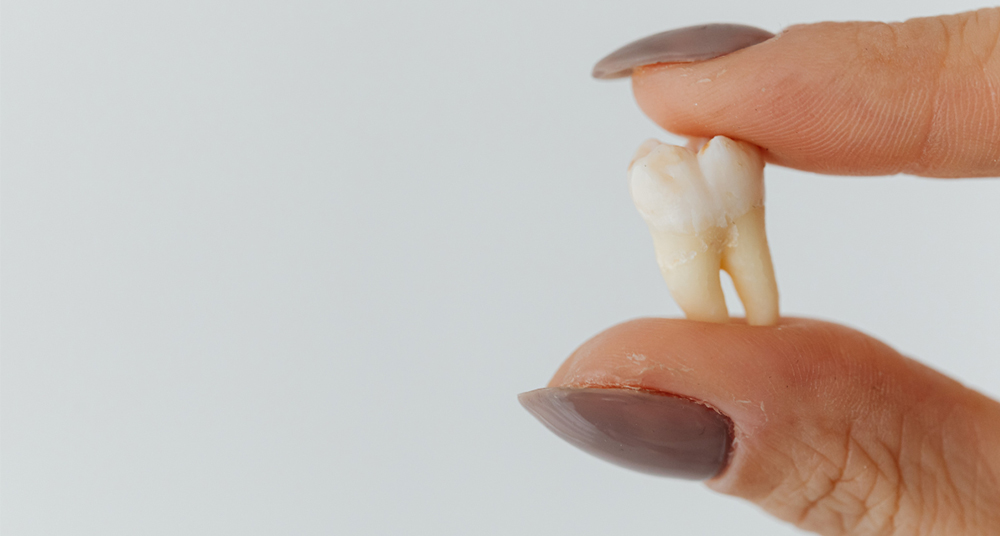Blog
Tooth Extraction: Planning Your Smile's Future
August 6, 2025 / DENTISTRY

When facing a tooth extraction...
When facing a tooth extraction, patients often focus solely on the removal procedure itself. However, planning for tooth replacement should begin before the tooth extraction takes place. At Caledon Dental Centre, the dental team emphasizes the importance of considering long-term smile restoration alongside immediate tooth extraction needs.
A tooth extraction represents just the first step in a comprehensive treatment plan. Modern dentistry offers excellent replacement options that can restore both function and aesthetics after tooth extraction. Understanding these options helps patients make informed decisions about their oral health future.
Understanding When Tooth Extraction Becomes Necessary
Several conditions may require tooth extraction, including severe decay, advanced gum disease, trauma, or overcrowding. Additionally, wisdom teeth often need removal due to impaction or insufficient space. The tooth extraction process itself has become more comfortable with modern techniques and sedation options.
Before any tooth extraction, dental professionals evaluate the tooth's condition thoroughly. X-rays reveal the extent of damage and help determine the best approach for removal. Furthermore, this evaluation period provides an ideal opportunity to discuss replacement options with patients.
The timing of replacement planning significantly impacts treatment success. When patients understand their options before tooth extraction, they can make decisions that optimize healing and final outcomes. Moreover, some replacement procedures require specific preparation during the tooth extraction process.
Dental Implants: The Gold Standard After Tooth Extraction
Dental implants represent the most comprehensive tooth replacement option following tooth extraction. These titanium posts integrate with jawbone tissue, creating a stable foundation for crown placement. Consequently, implants provide the closest approximation to natural tooth function and appearance.
The implant process typically begins 3-6 months after tooth extraction, allowing adequate healing time. However, immediate implant placement may be possible in certain cases with healthy bone structure. The dental team at Caledon Dental Centre evaluates each situation individually to determine optimal timing.
Implant success rates exceed 95% when proper protocols are followed. Additionally, implants help preserve jawbone density by providing stimulation similar to natural tooth roots. This bone preservation prevents the facial changes that often occur after tooth loss.
Patients appreciate that implants don't affect adjacent teeth, unlike other replacement options. Furthermore, implants can last decades with proper care, making them a cost-effective long-term solution. The investment in implant therapy often pays dividends in improved quality of life and oral health.
Bridge Options Following Tooth Extraction Procedures
Dental bridges offer another excellent replacement option after tooth extraction. Traditional bridges use adjacent teeth as anchors, supporting a replacement tooth in the extraction site. This approach works particularly well when neighboring teeth already need crowns or have large fillings.
The bridge process typically begins 2-4 weeks after tooth extraction, once initial healing is complete. During this time, patients may wear a temporary replacement to maintain aesthetics and function. Subsequently, the permanent bridge is custom-crafted to match surrounding teeth perfectly.
Modern bridge materials provide exceptional durability and natural appearance. Porcelain and ceramic options blend seamlessly with existing teeth, creating beautiful, functional results. Additionally, bridges restore chewing ability and prevent adjacent teeth from shifting into the extraction space.
Bridge maintenance requires special attention to cleaning under the replacement tooth. However, with proper care, bridges can serve patients well for 10-15 years or longer. The dental team provides detailed instructions for bridge care and maintenance.
Denture Solutions After Multiple Tooth Extraction Cases
When multiple teeth require extraction, dentures may provide the most practical replacement solution. Modern dentures offer improved comfort, function, and aesthetics compared to previous generations. Additionally, various denture types accommodate different patient needs and preferences.
Immediate dentures can be placed directly after tooth extraction, eliminating the period without teeth. However, these require adjustments as healing progresses and tissues change shape. Alternatively, conventional dentures are fabricated after complete healing, typically 6-8 weeks post-extraction.
Implant-supported dentures combine the stability of implants with the comprehensive coverage of dentures. This hybrid approach provides superior retention and chewing ability compared to traditional dentures. Furthermore, implant support helps preserve jawbone structure over time.
Partial dentures work well when some natural teeth remain healthy. These removable appliances fill extraction spaces while preserving existing teeth. Moreover, partial dentures can be modified if additional teeth require extraction in the future.
Timing Considerations for Tooth Extraction and Replacement
Proper timing plays a crucial role in successful tooth replacement after tooth extraction. Immediate replacement isn't always possible or advisable, depending on the extraction circumstances. Infections, extensive bone loss, or complex extractions may require extended healing periods.
The healing timeline varies among patients, but general guidelines help with planning. Soft tissue healing typically occurs within 2-4 weeks, while bone remodeling continues for several months. Consequently, replacement timing must account for these biological processes.
Some replacement options require specific preparation during tooth extraction. For example, socket preservation techniques can maintain bone volume for future implant placement. Additionally, immediate implant placement requires careful case selection and surgical expertise.
Patients should discuss timing preferences with their dental team before tooth extraction. Work schedules, special events, and personal preferences all factor into treatment planning. Furthermore, temporary replacement options can maintain aesthetics during the healing period.
Planning Your Smile's Future After Tooth Extraction
Successful tooth replacement begins with comprehensive planning before tooth extraction. The dental team at Caledon Dental Centre works closely with patients to develop personalized treatment plans. These plans consider medical history, lifestyle factors, and aesthetic goals.
Financial planning also plays an important role in treatment decisions. Different replacement options have varying costs and insurance coverage levels. However, investing in quality tooth replacement often prevents more expensive problems in the future.
Patients should consider their long-term oral health goals when choosing replacement options. While cost may influence initial decisions, the most economical choice isn't always the least expensive upfront. Quality replacements provide better function, durability, and satisfaction over time.
Recovery and Aftercare Following Tooth Extraction
Proper aftercare following tooth extraction significantly impacts healing success and replacement outcomes. The dental team provides detailed post-operative instructions to ensure optimal recovery. Following these guidelines helps prevent complications and prepares the site for future restoration.
Immediately after tooth extraction, patients should avoid disturbing the blood clot that forms in the socket. This clot protects the underlying bone and promotes healing. Additionally, patients should avoid smoking, drinking through straws, and vigorous rinsing for the first 24-48 hours.
Pain management after tooth extraction typically involves over-the-counter medications as directed. Ice packs applied to the outside of the face can help reduce swelling during the first day. Furthermore, eating soft foods and maintaining gentle oral hygiene supports the healing process.
Follow-up appointments allow the dental team to monitor healing progress and address any concerns. These visits also provide opportunities to discuss replacement timing and finalize treatment plans. Regular monitoring ensures the best possible outcomes for both healing and restoration.
Your Tooth Extraction and Replacement Partner in Caledon
At Caledon Dental Centre, the experienced team guides patients through every step of the tooth extraction and replacement process. Located at 12570 Kennedy Road, Unit #10, Caledon L7C 4C4, the practice offers comprehensive services under one roof.
The team's extended hours—weekdays from 11:00 AM to 7:00 PM and weekends from 9:00 AM to 4:00 PM—accommodate busy schedules. This flexibility ensures patients can receive timely care throughout their treatment journey.
Don't let tooth extraction anxiety prevent you from getting needed care. Contact Caledon Dental Centre at 905-843-2500 or email info@caledondentalcentre.com to discuss your options. Together, the team can create a treatment plan that restores your smile and confidence.
Archive
- Emergency Dentist in Caledon: True Cost of Dental Emergencies
- Family Dentist in Caledon: New Family Checklist
- Dentist in Caledon: Stained to Stunning Whitening
- Dentist Accepting CDCP and ODSP: Complete Guide
- Tooth Extraction: Planning Your Smile's Future
- Dentist Open on Saturday and Sunday: Family Solutions
- Emergency Dentist in Caledon: 7 Signs You Can't Wait
- What Sets Our Caledon Family Dentist Apart? A Closer Look
- Dentist in Caledon: Dental Care for Seniors - What You Need to Know
- How to Take Care of Your Child’s Teeth Trough Pediatric Dentistry
- Wisdom Teeth: When and Why They Might Need to Be Removed
- The Benefits of Fluoride Treatments for Adults and Children
- Protecting Your Smile: The Importance of Mouthguards in Sports
- Debunking Common Myths About Dental Care: Separating Fact from Fiction
- Managing Tooth Sensitivity: Causes and Solutions
- The Surprising Link Between Oral Health and Heart Disease
- Proper Care and Maintenance of Dental Implants
- Exploring Cosmetic Dentistry: Procedures and Benefits
- The Benefits of Invisalign for Straighter Teeth
- The Connection Between Gum Health and Overall Well-being
- Unmasking Tooth Sensitivity: Causes, Treatment, and Prevention
- Choosing the Right Toothbrush and Toothpaste for Your Family
- Crowns, Bridges, and Dentures: Caring for Your Dental Restorations
- Dental Woes Begone: Common Dental Problems and Their Solutions
- The Importance of Regular Dental Check-ups: What to Expect
- 5 Benefits Of Wearing a Mouthguard for Contact Sports
- Myths and Facts About the Use of Fluoride in Dentistry
- Dental Emergencies: What You Need to Know
- Three Tips for Maintaining the Best Oral Hygiene and Building a Healthy Smile that Lasts
- Why it’s Time to Consider Professional Tooth Whitening
- Dental X-Rays: When and How Often Do You Need Them?
- The Differences Between Store-Bought and Custom-Fit Mouthguards
- Dental Care for Seniors
- Everything You Need to Know About Tooth Extractions
- Everything You Need to Know About Cold Sores
- The Importance of Straight Teeth
- Understanding Why You Need Dental X-Rays
- Everything You Need to Know About Oral Healthcare for Seniors
- The Importance of Oral Health to You Overall Wellness
- Tooth Whitening at Home with Your Caledon Dentist
- Helping you Build a Bright, Confident Smile
- Helping you Build a Bright, Confident Smile
- Everything You Need to Know About Root Canals
- Should You Have Your Wisdom Teeth Removed?
- When Brushing Just Isn't an Option
- Restore Your Smile with Natural-Looking Inlays and Onlays
- Why Regular Dental Check-ups Are Important to Your Health



